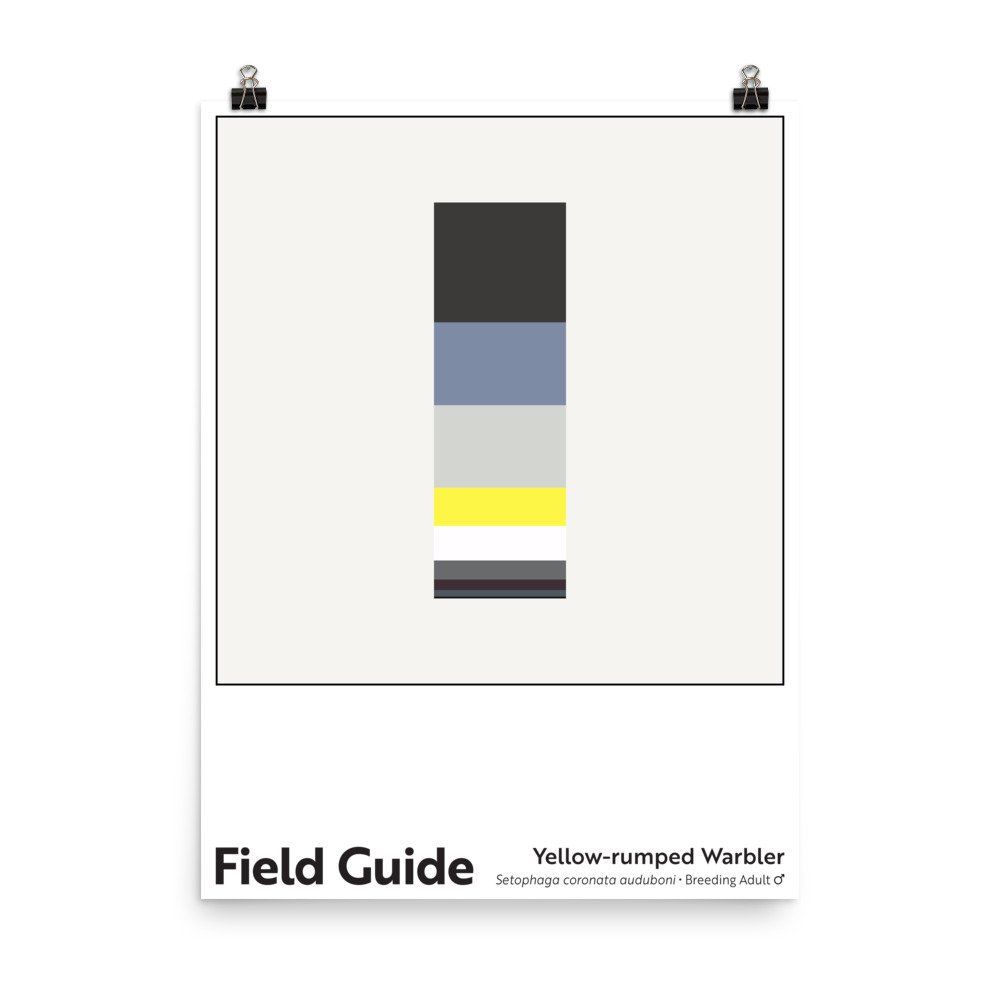 Image 1 of 1
Image 1 of 1


Field Guide : Yellow-rumped Warbler (Male)
Unlimited edition. 18 x 24 inch, museum-quality poster on matte paper.
One “version” of a species that’s caused a lot of taxonomic handwringing over the last fifty years. First, it was considered multiple species. Then, those different species were reclassified as just one, comprising two to four subspecies. Next came a genus reassignment. Things still aren’t settled; ornithologists continue to argue about the yellow-rumped warbler’s classification. I’m more of a lumper than a splitter, so I’m down with the current consensus: one species, the yellow-rumped warbler (Setophaga coronata), with two to four subspecies, most notably the Audubon’s warbler (Setophaga coronata auduboni) in western North America and the Myrtle warbler (Setophaga coronata coronata) in the east. No matter how we lump or split the species, though, English-speaking birders call them “butter butts” 🧈🍑and usually note their presence with ennui (“Oh, just some butter butts.”). That muted response is due to the warbler’s prevalence, but – wow! – the breeding male Audubon’s warbler cuts a rakish profile! Look at those bands of warm charcoal, cool slate and alabaster, and brilliant yellow. I can’t bring myself to call such a sharp-dressed guy a “butter butt,” so I’ll use the direct translation of the bird’s scientific binomial instead, “crowned moth eater.” 👑🦋😋
Note: These archival poster prints feature rich, appealing colors. I encourage customers to take care in handling them until they are framed/protected for display; the darker colors on the matte paper can be scratched. They ship rolled, so customers need to flatten them before framing (or have their framer do so).
Charitable Sales Model: Whenever one of these poster prints is purchased, a charitable contribution equal to 10% of the print’s cost (or $3.60) is made to a nonprofit working to tackle environmental or social challenges. Read more about my charitable sales model here.
Unlimited edition. 18 x 24 inch, museum-quality poster on matte paper.
One “version” of a species that’s caused a lot of taxonomic handwringing over the last fifty years. First, it was considered multiple species. Then, those different species were reclassified as just one, comprising two to four subspecies. Next came a genus reassignment. Things still aren’t settled; ornithologists continue to argue about the yellow-rumped warbler’s classification. I’m more of a lumper than a splitter, so I’m down with the current consensus: one species, the yellow-rumped warbler (Setophaga coronata), with two to four subspecies, most notably the Audubon’s warbler (Setophaga coronata auduboni) in western North America and the Myrtle warbler (Setophaga coronata coronata) in the east. No matter how we lump or split the species, though, English-speaking birders call them “butter butts” 🧈🍑and usually note their presence with ennui (“Oh, just some butter butts.”). That muted response is due to the warbler’s prevalence, but – wow! – the breeding male Audubon’s warbler cuts a rakish profile! Look at those bands of warm charcoal, cool slate and alabaster, and brilliant yellow. I can’t bring myself to call such a sharp-dressed guy a “butter butt,” so I’ll use the direct translation of the bird’s scientific binomial instead, “crowned moth eater.” 👑🦋😋
Note: These archival poster prints feature rich, appealing colors. I encourage customers to take care in handling them until they are framed/protected for display; the darker colors on the matte paper can be scratched. They ship rolled, so customers need to flatten them before framing (or have their framer do so).
Charitable Sales Model: Whenever one of these poster prints is purchased, a charitable contribution equal to 10% of the print’s cost (or $3.60) is made to a nonprofit working to tackle environmental or social challenges. Read more about my charitable sales model here.